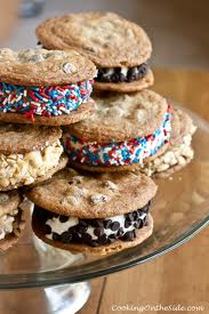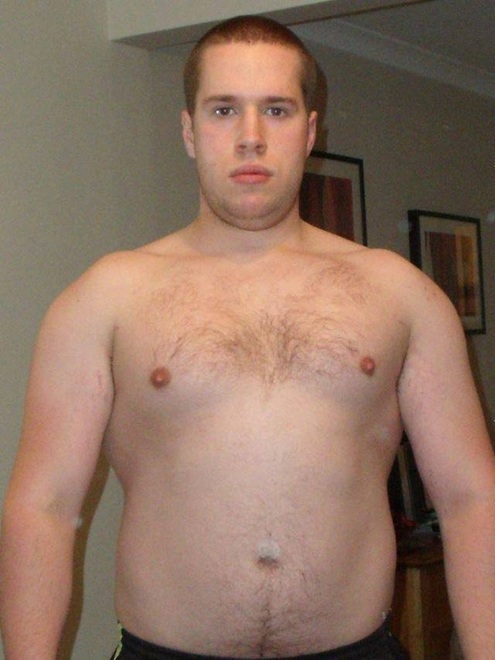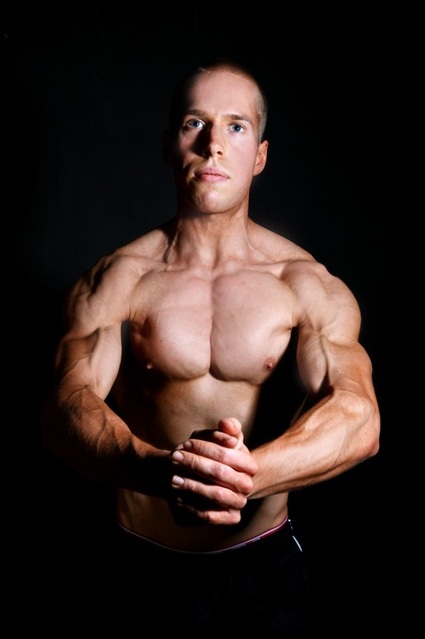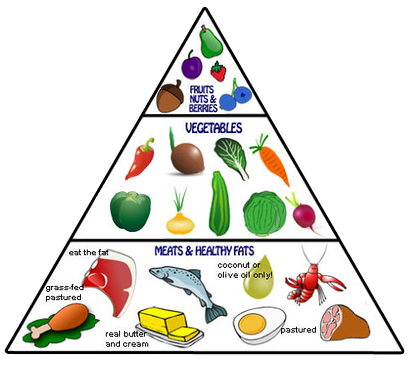
By Mike Samuels
You can find all of Mike's work and learn about him at www.healthylivingheavylifting.com
Enter Mike…..
He’s health personified. A 20-year old personal trainer who preaches the benefits of clean eating.
His clients know they need to avoid refined grains. Meals should revolve around protein and vegetables. If carbs are to be included in a meal, they should only come in the post-workout period, and even then, should only be from fruits, sweet potato, or possibly brown rice, couscous or quinoa.
Mike doesn’t eat dairy. Or gluten. He’s not lactose intolerant or celiac, he just knows that foods containing these aren’t part of a healthy diet. As for artificial sweeteners, you’re kidding, right? When Mike goes out for a meal he doesn’t even look at the menu – he orders steak and asks to swap the side to vegetables or salad, and it’s water, not soft drinks, or – heaven forbid – alcohol that accompanies this fare.
Here’s the thing though…..
Mike’s fat
Okay, we’re not talking obese here, but despite his healthy ways, his food avoidance, and strict adherence to what most would refer to as “clean eating,” Mike’s no cover model.
I’m Mike.
Yep, that’s me.
At least that was me. Now my diet’s slightly different. I still stick kind of to the diet detailed above, but now I eat cereals for breakfast. I have ice cream most days, eat out at pizza restaurants, Mexicans, Indian and Chinese restaurants and order from the menu a couple of times per week, and put Splenda in every coffee I drink.
Considering my diet’s now a lot “worse” you’d expect me to be pretty fat right about now. Well…..
I’m Mike.
Yep, that’s me.
At least that was me. Now my diet’s slightly different. I still stick kind of to the diet detailed above, but now I eat cereals for breakfast. I have ice cream most days, eat out at pizza restaurants, Mexicans, Indian and Chinese restaurants and order from the menu a couple of times per week, and put Splenda in every coffee I drink.
Considering my diet’s now a lot “worse” you’d expect me to be pretty fat right about now. Well…..
Yep, that’s me. Let me explain…..
(For the methods used to get this kind of transformation, go here –http://www.healthylivingheavylifting.com/flexible-fat-loss/ )
It Started with Paleo
Back in 2011, I was a staunch advocate of Paleo eating.
If you’re unfamiliar, paleo eating is the caveman diet. You basically eat as close possible to how our ancient ancestors supposedly did 10,000 years ago. That means you eat some kind of animal protein at every meal. This is accompanied by (preferably in-season) fruits and vegetables. You can eat nuts and seeds too, plus some oils, but Paleo is mainly defined by the foods you can’t consume, which include -
- Grains (That’s all grains – brown, white, wholegrain, it doesn’t matter.)
- Dairy (Some versions of the Paleo diet allow butter and cream, but that’s it.)
- Legumes. Yep, those harmless little kidney beans in your chilli, or the lentils you use to make your vegetable soup – they’re banned too. Apparently ancient man didn’t have access to the facilities needed to make beans, legumes and pulses safe for human consumption, plus they’re pro-inflammatory, so they’re off the menu.
- There’s also the obvious ones, like microwave meals, artificial sweeteners, pastry, junk foods, alcohol, and so on.
(For the methods used to get this kind of transformation, go here –http://www.healthylivingheavylifting.com/flexible-fat-loss/ )
It Started with Paleo
Back in 2011, I was a staunch advocate of Paleo eating.
If you’re unfamiliar, paleo eating is the caveman diet. You basically eat as close possible to how our ancient ancestors supposedly did 10,000 years ago. That means you eat some kind of animal protein at every meal. This is accompanied by (preferably in-season) fruits and vegetables. You can eat nuts and seeds too, plus some oils, but Paleo is mainly defined by the foods you can’t consume, which include -
- Grains (That’s all grains – brown, white, wholegrain, it doesn’t matter.)
- Dairy (Some versions of the Paleo diet allow butter and cream, but that’s it.)
- Legumes. Yep, those harmless little kidney beans in your chilli, or the lentils you use to make your vegetable soup – they’re banned too. Apparently ancient man didn’t have access to the facilities needed to make beans, legumes and pulses safe for human consumption, plus they’re pro-inflammatory, so they’re off the menu.
- There’s also the obvious ones, like microwave meals, artificial sweeteners, pastry, junk foods, alcohol, and so on.
Herein Lies the Issue
I have no issue with the concept of the Paleo diet. I mean, what’s not to like in terms of health and fat loss about basing your meals round meat, fish and eggs, eating plenty of vegetables, some fruits, and then filling up on nuts and berries. Leaving aside the needlessness of the banned foods (which we’ll touch on later) it seems pretty sound.
But
With the Paleo diet, there are no rules on how much you can eat. By that, I mean you’re not given a set calorie or macronutrient goal to hit each day, as the theory behind Paleo eating is that the low-carb, high-protein nature of the diet leads you to feeling naturally full, and prevents over-eating.
Well, say hello to the incredible eating machine. Also known as “bottomless pit Samuels,” or “the human bin.” I don’t seem to have a full setting. When I’m not given a set amount to eat, I just eat.
For me, a typical day of Paleo eating meant eggs for breakfast. “Eggs you say? I’ll take five. And we’re allowed nuts on Paleo? Well then, I’ll load up a bowl with some cashews and almonds and snack on those.”
I’d carry on snacking on nuts, and maybe the odd bit of fruit until lunchtime, when it was inevitably more meat or fish with veggies. As you can see from the food pyramid, you’re supposed to eat the fat on meats, which meant I’d devour a hefty serving of full-fat beef or lamb mince, or a couple of salmon fillets, accompanied by four or five different veggies — all cooked in oil or grass-fed butter.
The afternoon snacks continued coming in the form of nuts and fruit and the odd protein shake. (Most paleo diets allow you to have protein powder. Weird, I know – it’s both man-made and dairy-based, yet you’re allowed it. As this isn’t intended to be a Paleo-bashing post however, we won’t touch on yet another flaw in the structure of the diet here.)
Dinner would be more or less what lunch was, and then I might snack a bit more in the evening – potentially a few boiled eggs, some fruit, or a protein pudding.
6 months into the Paleo diet, I’d gained weight.
Sure, my strength in the gym had gone up too, but I’d got fat. I was at a loss – I’d followed the diet probably 95% to the letter, yet instead of looking like all these Paleo-loving Crossfit athletes, with their 6-packs and biceps veins, I was one chunky SOB.
See, because of Paleo’s lack of accounting for calories, and it’s tendency to recommend low-carb, but higher-fat food sources, my calorie intake was through the roof. As I’d not been allowed some of my favourite foods like oats, rice, cottage cheese, beans and bread, I’d compensated by filling up on more of the foods I was allowed. End result = a “healthy” diet that had made me overweight.
Out went the rules, in came MyFitnessPal
I did some reading and research, and found where I’d been going wrong.
Instead of looking at foods as good vs. bad, I should have been looking at my overall diet as a whole.
This is a concept a lot of folks fail to grasp.
See, a diet isn’t about good and bad foods – it’s about numbers. To lose fat, you MUST be in a calorie deficit, meaning you’re burning more calories than you consume. In theory, you can lose weight eating whatever foods you want, provided you’re in a deficit.
This has been demonstrated a good deal in the media, with perhaps the most well-know, and often cited story being Jared: The Subway guy -
http://www.nydailynews.com/life-style/health/jared-subway-guy-marks-15-years-turkey-subs-article-1.1365511
More recently, there’s been examples with the University professor who based his diet around Twinkies - http://articles.latimes.com/2010/dec/06/health/la-he-fitness-twinkie-diet-20101206 and the man who lost 56 pounds in 6 months eating only McDonalds - http://www.dailymail.co.uk/femail/article-2575755/Getting-fit-fast-food-Man-lost-56lbs-eating-McDonalds-six-months-documents-experience-new-book.html
It isn’t ALL about calories though. Other factors do come into play, and those factors are in the form of macronutrients – proteins, carbohydrates and fats. For more on those, check out my article on calculating your macronutrients for a fat loss diet -
http://www.healthylivingheavylifting.com/how-to-calculate-macros-for-cutting/
I realised that I’d been looking too much into supposed food “quality” and not enough at food quantity. I needed to start tracking my intake, so I signed up with MyFitnessPal, a site that allows you to input all the food you eat in a day, and keeps a running total of your calories and macronutrients.
Then came Layne Norton: The Man, The Myth, The Legend
After doing some digging, I began tracking my macros, and had made some steady progress. But I was still, by definition a “clean eater.” I really struggled to get my carbs in, and resorted to big portions of the same foods all the time – mainly fruit, oats and rice, to bump up my intake. I was also having a hard time keeping my fat intake down, having been so used to cooking everything in oil or butter, snacking on nuts and choosing fatty meats all the time.
I decided to reach out to someone for help, and went to Layne Norton – a natural pro bodybuilder, record-holding powerlifter, and, get this – a nutritional scientist with a PHD.
Layne sent me through my plan after a consultation, and we got to work.
The line in the plan that struck me, and stays with me until this day, was this -
“It matters much less WHAT you eat than the number of protein/carbs/fats you take in. It is important to get as close to your numbers as possible.”
Quantity trumps “quality” every time.
I’m Mike, and I’m a recovering clean eater
As things progressed, and time went by, I started to break my clean eating habits. I realised I could have a beer with friends at the pub, that if we went out for a meal, it was okay to order something “normal” and that if I wanted some chocolate, I could have it.
In my restrictive Paleo days, I’d been prone to binge eating. I’d go three or four weeks sticking perfectly to my plan, then find my cravings for non-Paleo foods got so huge I’d succumb to 5 -6,000 calorie binge on cereals, cake and chips.
(NB: Take a look at my post on cheat meals – Cheat Meals: The Rock(y) Road to a Crappy Physique - http://www.healthylivingheavylifting.com/cheat-meals-the-rocky-road-to-a-crappy-physique/ )
Fast Forward to 2013
And I decided that I was lean enough to justify stripping down to my skimpies and doing a photo shoot.
While dieting was tough, and by the end, my carb and fat intake was relatively low (around 120g and 65g per day respectively) I had NO RESTRICTIONS on what I could and couldn’t eat. Most of my foods certainly came from nutrient-dense, minimally processed sources, and I was a meat and veggie-eating machine. But I also made frequent trips to Subway to grab lunch between clients, I ate ice cream every single re-feed day (and on some non refeed days too,) I went on holiday to Amsterdam and Barcelona, and eyeballed all my food, eating Pop Tarts, burgers, pizza, pasta and sandwiches, and drinking beer and cocktails, and ended up the leanest I’ve ever been. All through simply tracking calories and macronutrients.
Get to the Point Samuels…..
What’s the point of this post?
It’s not an attempt to bash anyone for following any type of restrictive, or rules-based diet, like Paleo, Atkins, Primal, Dukan, or whatever, and it’s certainly not meant to encourage people to base their diets around junk foods.
What it hopefully serves to do, however, is to make you realise that there’s much, much more to a diet than good vs. bad foods. You needn’t cut out any food when trying to lose fat – it’s simply about eating mostly healthy, unprocessed foods and controlling your calorie and macronutrient intake, but not freaking out if you do include high-sugar, high-fat and processed foods, provided they fit in with your plan as a whole.
The main reason people screw up when dieting is a lack of consistency. This inconsistency comes through boredom, or feeling that a diet is simply too hard going. For most people, this is almost bound to happen when following a diet with lots of rules, that doesn’t permit them to eat their favourite foods.
Moderation is key. Moderation lets you eat ice cream and Subway and get lean. Moderation is awesome.
For more on how to set up your own flexible diet - http://www.healthylivingheavylifting.com/flexible-fat-loss/
I have no issue with the concept of the Paleo diet. I mean, what’s not to like in terms of health and fat loss about basing your meals round meat, fish and eggs, eating plenty of vegetables, some fruits, and then filling up on nuts and berries. Leaving aside the needlessness of the banned foods (which we’ll touch on later) it seems pretty sound.
But
With the Paleo diet, there are no rules on how much you can eat. By that, I mean you’re not given a set calorie or macronutrient goal to hit each day, as the theory behind Paleo eating is that the low-carb, high-protein nature of the diet leads you to feeling naturally full, and prevents over-eating.
Well, say hello to the incredible eating machine. Also known as “bottomless pit Samuels,” or “the human bin.” I don’t seem to have a full setting. When I’m not given a set amount to eat, I just eat.
For me, a typical day of Paleo eating meant eggs for breakfast. “Eggs you say? I’ll take five. And we’re allowed nuts on Paleo? Well then, I’ll load up a bowl with some cashews and almonds and snack on those.”
I’d carry on snacking on nuts, and maybe the odd bit of fruit until lunchtime, when it was inevitably more meat or fish with veggies. As you can see from the food pyramid, you’re supposed to eat the fat on meats, which meant I’d devour a hefty serving of full-fat beef or lamb mince, or a couple of salmon fillets, accompanied by four or five different veggies — all cooked in oil or grass-fed butter.
The afternoon snacks continued coming in the form of nuts and fruit and the odd protein shake. (Most paleo diets allow you to have protein powder. Weird, I know – it’s both man-made and dairy-based, yet you’re allowed it. As this isn’t intended to be a Paleo-bashing post however, we won’t touch on yet another flaw in the structure of the diet here.)
Dinner would be more or less what lunch was, and then I might snack a bit more in the evening – potentially a few boiled eggs, some fruit, or a protein pudding.
6 months into the Paleo diet, I’d gained weight.
Sure, my strength in the gym had gone up too, but I’d got fat. I was at a loss – I’d followed the diet probably 95% to the letter, yet instead of looking like all these Paleo-loving Crossfit athletes, with their 6-packs and biceps veins, I was one chunky SOB.
See, because of Paleo’s lack of accounting for calories, and it’s tendency to recommend low-carb, but higher-fat food sources, my calorie intake was through the roof. As I’d not been allowed some of my favourite foods like oats, rice, cottage cheese, beans and bread, I’d compensated by filling up on more of the foods I was allowed. End result = a “healthy” diet that had made me overweight.
Out went the rules, in came MyFitnessPal
I did some reading and research, and found where I’d been going wrong.
Instead of looking at foods as good vs. bad, I should have been looking at my overall diet as a whole.
This is a concept a lot of folks fail to grasp.
See, a diet isn’t about good and bad foods – it’s about numbers. To lose fat, you MUST be in a calorie deficit, meaning you’re burning more calories than you consume. In theory, you can lose weight eating whatever foods you want, provided you’re in a deficit.
This has been demonstrated a good deal in the media, with perhaps the most well-know, and often cited story being Jared: The Subway guy -
http://www.nydailynews.com/life-style/health/jared-subway-guy-marks-15-years-turkey-subs-article-1.1365511
More recently, there’s been examples with the University professor who based his diet around Twinkies - http://articles.latimes.com/2010/dec/06/health/la-he-fitness-twinkie-diet-20101206 and the man who lost 56 pounds in 6 months eating only McDonalds - http://www.dailymail.co.uk/femail/article-2575755/Getting-fit-fast-food-Man-lost-56lbs-eating-McDonalds-six-months-documents-experience-new-book.html
It isn’t ALL about calories though. Other factors do come into play, and those factors are in the form of macronutrients – proteins, carbohydrates and fats. For more on those, check out my article on calculating your macronutrients for a fat loss diet -
http://www.healthylivingheavylifting.com/how-to-calculate-macros-for-cutting/
I realised that I’d been looking too much into supposed food “quality” and not enough at food quantity. I needed to start tracking my intake, so I signed up with MyFitnessPal, a site that allows you to input all the food you eat in a day, and keeps a running total of your calories and macronutrients.
Then came Layne Norton: The Man, The Myth, The Legend
After doing some digging, I began tracking my macros, and had made some steady progress. But I was still, by definition a “clean eater.” I really struggled to get my carbs in, and resorted to big portions of the same foods all the time – mainly fruit, oats and rice, to bump up my intake. I was also having a hard time keeping my fat intake down, having been so used to cooking everything in oil or butter, snacking on nuts and choosing fatty meats all the time.
I decided to reach out to someone for help, and went to Layne Norton – a natural pro bodybuilder, record-holding powerlifter, and, get this – a nutritional scientist with a PHD.
Layne sent me through my plan after a consultation, and we got to work.
The line in the plan that struck me, and stays with me until this day, was this -
“It matters much less WHAT you eat than the number of protein/carbs/fats you take in. It is important to get as close to your numbers as possible.”
Quantity trumps “quality” every time.
I’m Mike, and I’m a recovering clean eater
As things progressed, and time went by, I started to break my clean eating habits. I realised I could have a beer with friends at the pub, that if we went out for a meal, it was okay to order something “normal” and that if I wanted some chocolate, I could have it.
In my restrictive Paleo days, I’d been prone to binge eating. I’d go three or four weeks sticking perfectly to my plan, then find my cravings for non-Paleo foods got so huge I’d succumb to 5 -6,000 calorie binge on cereals, cake and chips.
(NB: Take a look at my post on cheat meals – Cheat Meals: The Rock(y) Road to a Crappy Physique - http://www.healthylivingheavylifting.com/cheat-meals-the-rocky-road-to-a-crappy-physique/ )
Fast Forward to 2013
And I decided that I was lean enough to justify stripping down to my skimpies and doing a photo shoot.
While dieting was tough, and by the end, my carb and fat intake was relatively low (around 120g and 65g per day respectively) I had NO RESTRICTIONS on what I could and couldn’t eat. Most of my foods certainly came from nutrient-dense, minimally processed sources, and I was a meat and veggie-eating machine. But I also made frequent trips to Subway to grab lunch between clients, I ate ice cream every single re-feed day (and on some non refeed days too,) I went on holiday to Amsterdam and Barcelona, and eyeballed all my food, eating Pop Tarts, burgers, pizza, pasta and sandwiches, and drinking beer and cocktails, and ended up the leanest I’ve ever been. All through simply tracking calories and macronutrients.
Get to the Point Samuels…..
What’s the point of this post?
It’s not an attempt to bash anyone for following any type of restrictive, or rules-based diet, like Paleo, Atkins, Primal, Dukan, or whatever, and it’s certainly not meant to encourage people to base their diets around junk foods.
What it hopefully serves to do, however, is to make you realise that there’s much, much more to a diet than good vs. bad foods. You needn’t cut out any food when trying to lose fat – it’s simply about eating mostly healthy, unprocessed foods and controlling your calorie and macronutrient intake, but not freaking out if you do include high-sugar, high-fat and processed foods, provided they fit in with your plan as a whole.
The main reason people screw up when dieting is a lack of consistency. This inconsistency comes through boredom, or feeling that a diet is simply too hard going. For most people, this is almost bound to happen when following a diet with lots of rules, that doesn’t permit them to eat their favourite foods.
Moderation is key. Moderation lets you eat ice cream and Subway and get lean. Moderation is awesome.
For more on how to set up your own flexible diet - http://www.healthylivingheavylifting.com/flexible-fat-loss/



